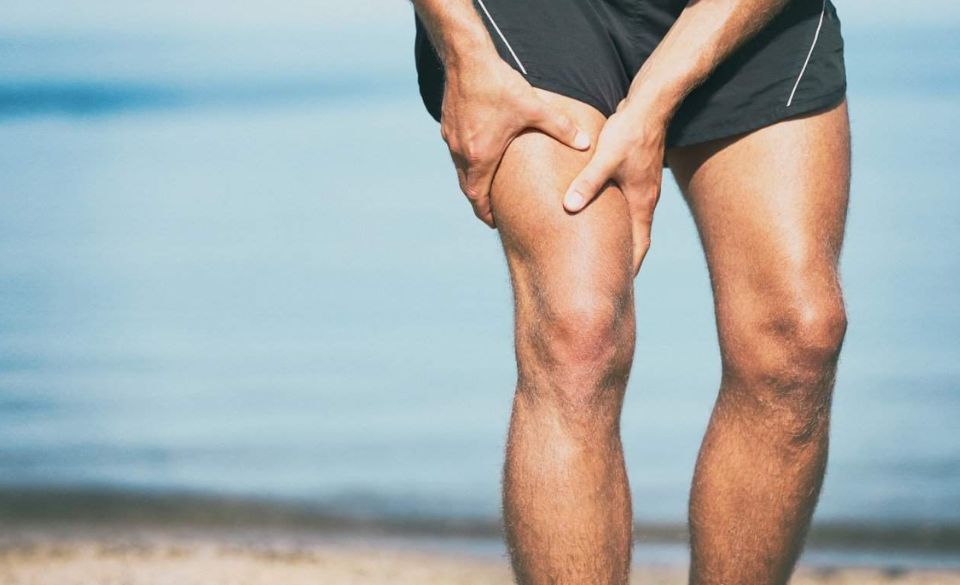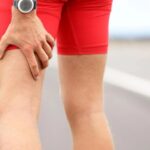
What Causes Sore Quads After Running
Page Contents
What Are The Quad Muscles?
The quad muscles are four large muscles that are located in the front of the thigh. These four muscles are the rectus femoris, the vastus lateralis, the vastus intermedius, and the vastus medialis. They are part of the extensor muscle group and they are the primary muscles responsible for the extension of the knee and the flexion of the hip.
The rectus femoris is a long, straight muscle that originates near the hip bone and inserts on the patella. It is the most powerful of the quad muscles and is involved in knee extension and hip flexion. This muscle is often injured due to its position and the amount of stress it is exposed to, especially with activities that involve a lot of running or jumping.
The vastus lateralis is one of the most powerful of the four quad muscles and it is the largest in size. It originates near the hip bone and inserts on the patella. It is responsible for knee extension and hip flexion and is commonly injured due to its position and the amount of stress it is exposed to.
The vastus intermedius is the third of the four quad muscles and is located between the vastus lateralis and the vastus medialis. It originates near the hip bone and inserts on the patella. It is responsible for knee extension and hip flexion and is commonly injured due to its position and amount of stress it is exposed to.
The vastus medialis is the smallest and least powerful of the four quad muscles. It originates near the hip bone and inserts on the patella. It is responsible for the lateral rotation of the hip joint and it is commonly injured due to its position and amount of stress it is exposed to.
The quad muscles play a major role in various activities that involve movement of the lower body such as running, jumping, and walking. Because of this, it is important to Strengthen and stretch these muscles as well as work on proper form and technique to avoid injury. Proper stretching and strengthening of the quad muscles can also help to improve performance and decrease the risk of injury during activities.
Certain conditions such as arthritis, tendonitis, or muscle strains can also cause pain and discomfort in the quad muscles. If left untreated, these conditions can result in further injury or even disability. It is important to consult with a doctor to determine the best course of action for treating these conditions.
In conclusion, the quad muscles are four powerful muscles located in the front of the thigh that are responsible for knee extension and hip flexion. Strengthening and stretching these muscles is important for athletic performance and for avoiding injury. Additionally, certain conditions such as arthritis, tendonitis, or muscle strains can cause pain and discomfort in these muscles and should be addressed by a doctor.
What Causes Sore Quads After Running
Sore quads after running is a common complaint among runners. There are several causes of sore quads after running, and understanding them can help you take steps to reduce or prevent the discomfort.
The first cause of sore quads after running is muscular fatigue. Muscular fatigue is caused when the muscles are being used more than they are used to, and they are not getting enough rest in between runs. Muscles can become fatigued due to running too far, too fast, or running on a non-level surface. When muscles become fatigued, they can become sore and tight, leading to sore quads.
The second cause of sore quads after running is lactic acid buildup. Lactic acid is a byproduct of the body’s energy production that accumulates in the muscles during exercise. This can cause the muscles to become sore and tight, leading to sore quads.
The third cause of sore quads after running is inadequate stretching. Stretching before and after running is important for maintaining flexibility and range of motion in the muscles. If stretching is not done regularly, the muscles can become tight and sore, leading to sore quads.
The fourth cause of sore quads after running is overtraining. Overtraining occurs when a runner increases the intensity or duration of their training too rapidly. This can cause the muscles to become overworked, leading to fatigue and soreness.
The fifth cause of sore quads after running is poor running form. Improper running form can put more strain on the muscles than necessary and can cause them to become sore and tight. Poor form can also lead to injuries, which can also lead to sore quads after running.
The sixth cause of sore quads after running is improper footwear. Wearing the wrong type of running shoes can cause the muscles to work harder than necessary and can lead to sore quads.
The seventh cause of sore quads after running is dehydration. Dehydration occurs when the body does not get enough fluids during exercise. Dehydration can cause the muscles to become tight and sore, leading to sore quads.
These are just a few of the causes of sore quads after running. Understanding the causes of sore quads can help you take steps to reduce or prevent the discomfort. Taking steps such as stretching regularly, wearing the right type of shoes, and staying hydrated can all help reduce the risk of sore quads after running.
How To Fix Sore Quads After Running
Sore quads after running can be a very common issue that runners experience. Fortunately, there are a few ways to help reduce the soreness after a hard run.
Firstly, proper warm up and cool down are essential to prevent soreness and injury. Before your running session, take 5-10 minutes to warm up your muscles by performing dynamic stretches such as walking lunges, high knees, and butt kicks. For your cool down, do 5-10 minutes of static stretching while focusing on your quads. This helps to relax the muscles and will reduce soreness after your run.
If you’ve already done your warm up and cool down and still experience sore quads, another good way to reduce soreness is to use a foam roller. Foam rolling your quads helps to break down muscle knots and can increase circulation to the area. Spend 2-3 minutes foam rolling each quad, slowly rolling from your hip to your knee. This can help reduce soreness and decrease your recovery time.
In addition to foam rolling, massage can be beneficial for reducing soreness in your quads. A massage can help to reduce inflammation and improve circulation in the area. If you don’t have access to a massage therapist, you can also use a massage ball or handheld massager to target your quads. Spend 5-10 minutes using either form of massage and focus on any tight or sore spots.
Finally, taking a hot shower or bath after your run can also help to reduce your sore quads. The heat helps to relax your muscles and increase circulation in the area, which can help to reduce pain and inflammation. If you don’t have access to a hot shower, you can also use a heating pad applied directly to the area for 15-20 minutes.
Sore quads after running can be a common issue for many runners, but fortunately, there are a few things you can do to help reduce your soreness. Taking the time to do a proper warm up and cool down before and after your run, foam rolling, massaging the area, and taking a hot shower or bath can all help to reduce your soreness and improve your recovery time.


